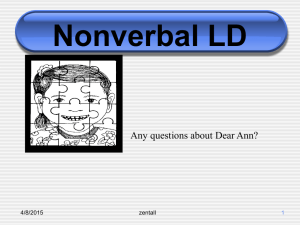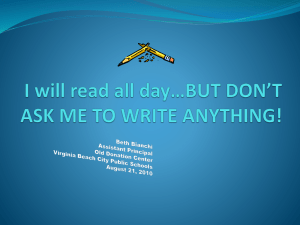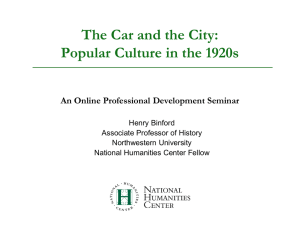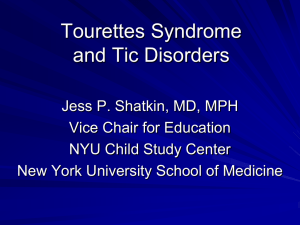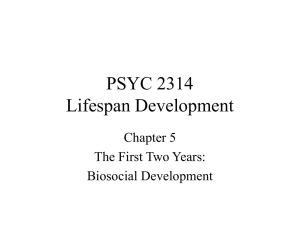Dyspraxia
advertisement
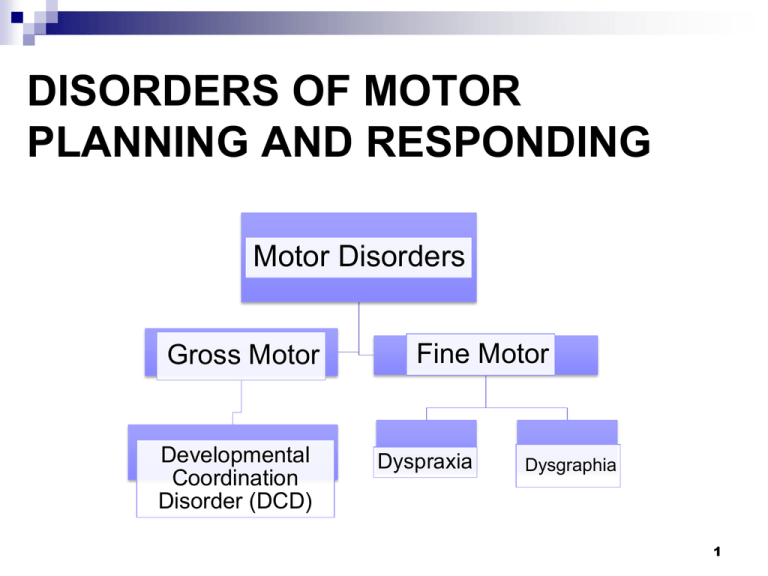
DISORDERS OF MOTOR PLANNING AND RESPONDING Motor Disorders Gross Motor Developmental Coordination Disorder (DCD) Fine Motor Dyspraxia Dysgraphia 1 Fred Fred was a quiet baby and babbled very little. He makes more babbling noises now (4 ½ yr.). He has never used words or jargon, but has developed a great deal of gesture for use in communication. He understands everything we say to him and enjoys stories and other verbal activities. He has begun to print words but only a few of these are used for purposeful communication. When Fred was 3 yr. and 9 mo. old he began to imitate animal noises. Most of these were produced with vowel sounds and an occasional ‘b’ or ‘k’. I remember a few weeks before his third birthday he repeated “bah, bah, bah” all one day. Thinking it might mean “bye-bye”, I took him out in an attempt to satisfy his whish and encourage him to continue, but he never repeated the sound after that day, so I may have been mistaken. 2 4/13/2015 zentall Fred cont. 3 At about the same time on three separate but identical occasions he made the sounds “wah dow”. I interpreted it to mean “want down” and helped him down. Then he learned to get down for himself and the sounds to my knowledge have never been repeated. Whether these were simply coincidences or not, I don’t know.expression, hand and body movements, etc. He will frequently “act out” verbs like fall, jump, etc. and sounds like escalator, revolving door, airplane, etc. When he was three years and 10 months old, I suddenly realized that Fred was reading words: dog, cat, etc. because he’d make the sounds for the animal when he saw only the word. At three years and eleven months he started making words all by himself with his alphabet blocks. Later he started printing the words; he was unable to make lower case letters well, but could translate lower case letters on toy blocks into capital letters. 4/13/2015 zentall Developmental Coordination Disorder 4/13/2015 Zentall 4 Dyspraxia 4/13/2015 zentall 5 Dyspraxia and Mislabeling 2 girls with Apraxia, a motor disorder, mistakenly labeled: 6 hearing impaired behavior disordered Another woman (undergrad in this course) was referred for testing at the age of 2 for not speaking—now also w/ bad handwriting and poor gross motor control, could run, however, because less motor skill involved. 4/13/2015 zentall Communication Specific characteristics of Apraxic speech include 4/13/2015 un-sequenced sounds or syllables inconsistent speech the loss of sounds or words during articulation Zentall 7 Look at this link Apraxia Video: listen to Brandon as an example of dyspraxia http://www.debtsmart.net/talk/inside_edition.html 4/13/2015 Zentall 8 Communication cont. Examples include "shif" instead of "fish" or "miskate" instead of "mistake" pronouncing "gate" as it should be one day, but replacing the "g" sound the next day with "k" or "d" and saying "kate" or "date" (Hall, Part I, 2000). 4/13/2015 Zentall 9 10 Dysgraphia. 11 History and handedness 4/13/2015 zentall 4/13/2015 zentall 12 8 yr old Dysgraphic 13 Vocabulary: 3 types of dysgraphia 14 1. memory dysgraphia 1. motor dysgraphia 2. 1. perceptual-spatial dysgraphia 3. 1. cannot recall the written form of letters but can copy cannot form letters but know that their writing is poor cannot form their letters and do not know that their writing or drawing is poor Learning Characteristics 1. Perception 2. Memory RESPONSE CHARACTERISTICS 1. Fine motor 15 16 17 4/13/2015 zentall ADHD and Dysgraphic 18 4/13/2015 zentall 19 4/13/2015 zentall Perceptual or Motor 20 4/13/2015 zentall Perceptual or Motor 21 4/13/2015 zentall Emotional Characteristics Students with dysgraphia are punished by… 1. staying in for recess to complete assignments 2. taking home excessive amounts of homework People may assume that they are… 1. Lazy 2. Careless 3. Not intelligent = Low self-efficacy & Low self-esteem 22 In contrast, writing forwards, backwards, upsidedown, upsidedown & backwards with either hand may look like giftedness: 23 Interventions 4/13/2015 Zentall 24 Deficit or Compensation Training? 25 Read this link 26 http://www.ldonline.org/article/6202 27 MOTOR TICS MOST develop: 1. eye tic first 2. facial tics or involuntary sounds 3. others within weeks or months common examples: head jerks, grimaces, hand-to-face movements 28 VERBAL TICS Stuttering Sounds (burping, gagging, barking) Words (‘oh boy’) Coprolalia (fewer than 15% have this) Occurs in late childhood Most disruptive and disturbing (Jay, 2000) 29 TOURETTE SYNDROME (VERBAL + MOTOR TICS): IDEA Category within Other Health Impaired (OHI) Tourette’s (versus tic disorder) Symptoms can: 1. 2. 3. change over time vary (frequency, type, location, or intensity) improve in less extreme cases during adulthood 30 SOCIAL EMOTIONAL Most problematic: in day-to-day & during adolescence Overall there is a higher risk of: 1.poor peer relationships 2.no relationships 3.withdrawn or aggressive social behavior 31 Academic Accommodations General Principle: 1.Tics increase as a function of stress and calling attention to tics increases them. 2. Tics decrease with relaxation or when focusing on an absorbing task ß 32 Model tolerance and do not allow teasing by peers Allow: 1. Short breaks 2. Placement options: movement around or outside the room access to a private room with a bean bag chair—with a private signal exams in a private room for tic release and allow more time 3. Tape student’s oral presentations 33 INTERVENTIONS Pharmacological interventions increase success 1. Anti-tic drugs block the activity of the neurotransmitter dopamine. 2. Anti-OCD drugs help to restore the brain chemical serotonin, which reduces unwanted, thoughts. (Many people choose tics over the medications because of side effects, which are sleepy, gain weight. In addition no medication has been found that eliminates tics completely.) 34 Quiet and Withdrawn 16% Yelling 5% Pacing 21% Random Talking/ Asking Questions 58% 35 1. Changes in students daily schedule: 2-hr. school delays, lack of aide in class, early dismissals, late bus arrivals. 2. Unstructured activities (breaks and times when waiting to load buses) 36 Diagnosis of OCD or Perfectionism? •Chris’ compulsions have to do with checking, ordering, repeating, and getting things ‘just right’ (perfectionism) rather than trivial concerns with contamination, something bad happening, or being neat and clean (OCD). •Behaviors are connected to an event in a realistic way and help him to neutralize the unpredictability of the event. 37 Diagnosis of ADHD? First determine mild mental retardation might not better explain his inattentive behavior. Follow-up: a. Now that he is given schoolwork based on his level of reading, language, and math, Chris is able to listen and sustain attention during his academics periods. b. He remains in his seat during class, never runs about the room, does not blurt out answers, and is able to wait his turn. Conclusion: Chris is not ADHD; he has a mild intellectual disability 38 Accommodations for the teacher: To address the child’s need for predictability and self-determination, teachers must provide: 1. A stable daily routine/schedule 2. Advance warning of any changes 3. Opportunities to ask questions as this is his way to reassure himself about a situation that is making him feel stressed and anxious 4. An escape, if needed, to regain control 39 Interventions for Chris to learn: To address the Chris’ need for self-determination, Chris must learn: 1. That when he cannot regain control, to ask for short breaks 2. To use scripts to interact with his peers. (For example, Chris does not know how to initiate a conversation; he only uses statements and needs to learn to ask questions.) 40
